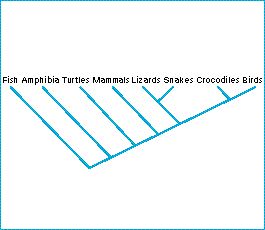The reconstruction of phylogeny - How do we infer phylogeny?

The tree of life
A phylogenetic tree, also known as a tree of life or simply a phylogeny, describes branching relationships among species, showing which species shares its most recent common ancestor with which other species.
A phylogeny implicitly has a time axis, and time usually goes up the page. The figure shows an example: the phylogeny of main vertebrate groups. Here, lizards and snakes share a more recent common ancestor with each other than either shares with any other species (or group of species).
Phylogenetic relations have to be inferred using homologies because the splitting events and common ancestors existed in the past and cannot be directly observed.
Two methods of phylogenetic inference:
1. Parsimony. Species are arranged in a phylogeny such that the smallest number of evolutionary changes is required.
2. Distance (or similarity.) Species are arranged in a phylogeny such that each species is grouped with the other species that it shares the most characters with.
Figure: phylogeny of main vertebrate groups.
| Next |



